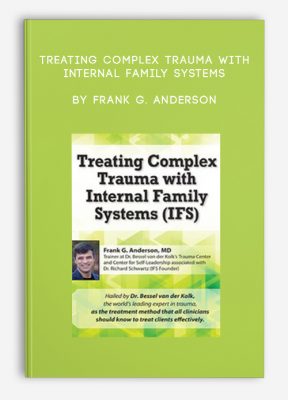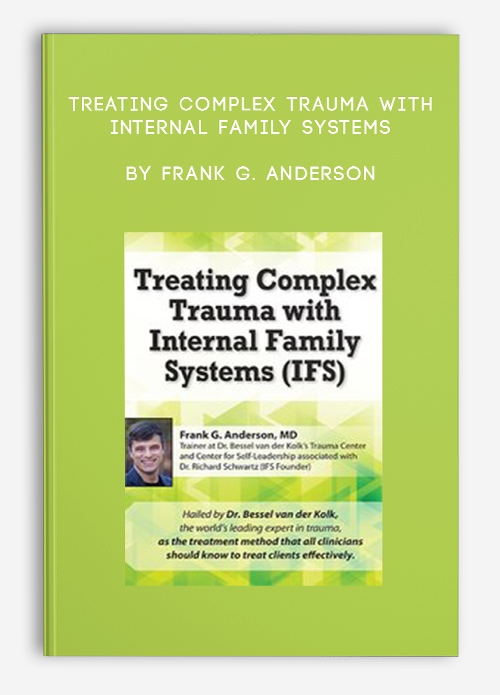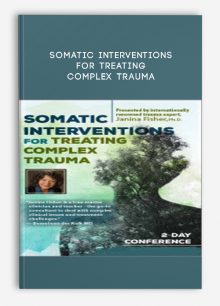Treating Complex Trauma with Internal Family Systems by Frank G. Anderson
$299.99 $89.00

Treating Complex Trauma with Internal Family Systems by Frank G. Anderson
**More information:
Get Treating Complex Trauma with Internal Family Systems at Salaedu.com
Description
Add additional power to your current clinical approach and make trauma treatment more effective in a short period of time when you incorporate Internal Family Systems (IFS) in your practice.
Join Dr. Frank Anderson, psychiatrist, author, and vice chair of the Foundation for Self Leadership — the leading organization dedicated to advancing the IFS model through research and training — in this comprehensive online course where he will give you a step–by–step guide for applying IFS into your clinical practice.
Throughout the online course, special emphasis will be given to understanding how trauma affects the brain and how you can use IFS to heal complex trauma and its common co-morbidities, including anxiety, depression, panic, insomnia, obsessive-compulsive behavior, and more.
You’ll also get exclusive insight on how neuroscience can inform why, how and what IFS techniques you should use to maximize your clinical outcomes — so you’ll know exactly how to empower your clients to overcome even the most complex traumas.
Learning IFS has never been easier — revolutionize your clinical approach and help your clients heal!
You’ll end this intensive online course prepared to start integrating Internal Family Systems with your current clinical models, plus you’ll earn 14 CE hours towards your IFS Certification.
You’ve likely heard your clients explain their feelings of conflicting emotions, “a part of me wants to…and then there’s a part of me that doesn’t…” as they grapple with their internal “Self,” desires, and behaviors.
With the transformative IFS approach, the idea of multiplicity of the mind is normal. Every part has a good intention, and every part has value. Even for trauma survivors.
Through engaging case studies, in-session demonstrations, and masterfully presented lectures, Dr. Frank Anderson will show you step-by-step how to apply the most effective, empirically-validated IFS interventions to help your clients listen to and understand their conflicting parts to master their emotions — so they can discover deep, lasting healing.
- Accelerate the healing from complex trauma by integrating the IFS model into your current clinical practice
- Improve assessment and treatment planning with tools to help identify, specify, and clarify the protective parts of clients with trauma histories
- Protect clients from emotional and psychological pain by offering an alternate view of symptoms and psychopathology that shows clients how parts are trying to protect them
- Showcase a non-pathological perspective of mental health disorders by demonstrating how IFS translates common comorbidities into parts language
- Increase your curious and compassionate self when using IFS to work with clients who have trauma histories.
- Improve clinical outcomes by learning how to differentiate between therapeutic and biological conditions.
- Heal clients’ traumatic wounds through the unique IFS internal attachment model.
- Handle extreme symptoms of trauma by determining if they are rooted in sympathetic activation or parasympathetic withdrawal.
- Gain quicker access to your client’s traumatic vulnerabilities through IFS specific therapeutic techniques that shift arousal and withdrawal.
- Use neuroscience to inform your therapeutic decision–making so you’ll know exactly what tool or strategy to use to help your clients heal.
- Integrate IFS with your current treatment approaches including EMDR, DBT, and Sensorimotor Psychotherapy.
– Janina Fisher, PhD
More information about Medical:
Medicine is the science and practice of establishing the diagnosis, prognosis, treatment, and prevention of disease.
Medicine encompasses a variety of health care practices evolved to maintain and restore health by the prevention and treatment of illness.
Contemporary medicine applies biomedical sciences, biomedical research, genetics, and medical technology to diagnose, treat, and prevent injury and disease,
typically through pharmaceuticals or surgery, but also through therapies as diverse as psychotherapy, external splints and traction, medical devices, biologics, and ionizing radiation, amongst others.
Medicine has been around for thousands of years, during most of which it was an art (an area of skill and knowledge) frequently having connections to the religious and
philosophical beliefs of local culture. For example, a medicine man would apply herbs and say prayers for healing, or an ancient philosopher and physician would apply bloodletting according to the theories of humorism.
In recent centuries, since the advent of modern science, most medicine has become a combination of art and science (both basic and applied, under the umbrella of medical science).
While stitching technique for sutures is an art learned through practice, the knowledge of what happens at the cellular and molecular level in the tissues being stitched arises through science.
1 review for Treating Complex Trauma with Internal Family Systems by Frank G. Anderson
Add a review Cancel reply
Related products
HEALTH - FITNESS - LIFESTYLE - MEDICAL
Somatic Interventions for Treating Complex Trauma with Janina Fisher, Ph.D. from Janina Fisher
HEALTH - FITNESS - LIFESTYLE - MEDICAL
HEALTH - FITNESS - LIFESTYLE - MEDICAL
HEALTH - FITNESS - LIFESTYLE - MEDICAL
HEALTH - FITNESS - LIFESTYLE - MEDICAL
HEALTH - FITNESS - LIFESTYLE - MEDICAL
Complete Certified Professional Coach Online Course from Berry Fowler
HEALTH - FITNESS - LIFESTYLE - MEDICAL










Trevis Trevis –
This is one of the most beautiful website and you can check the reviews of my website here: https://salaedu.com/clients-proof-and-reviews/